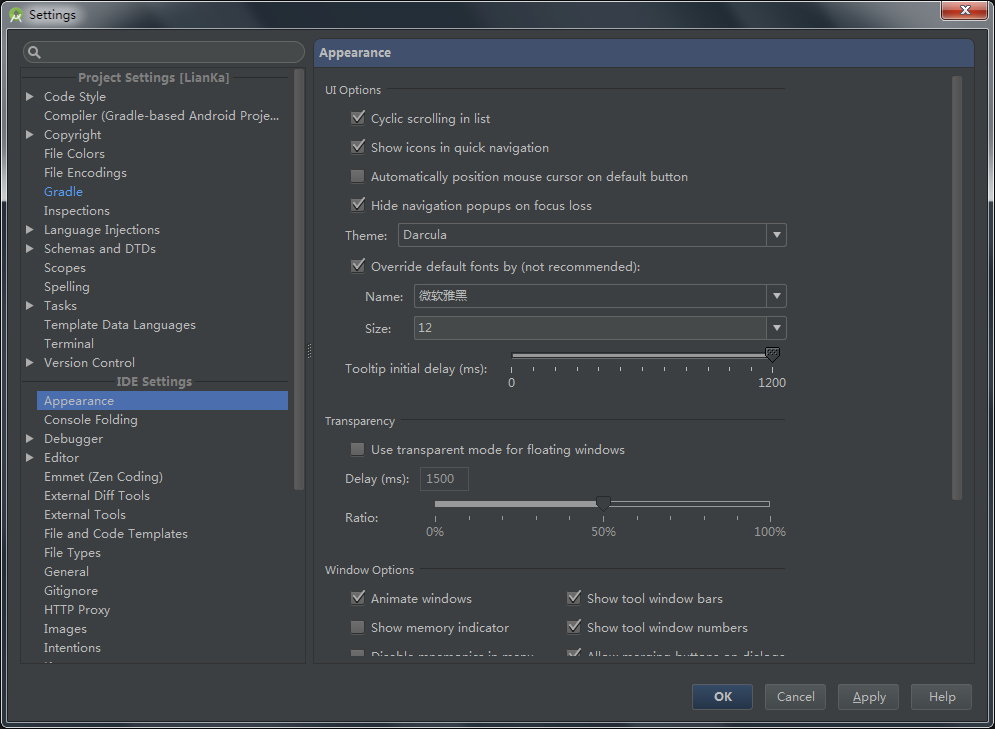編輯:關於Android編程
本文實例講解了Android中的自定義屬性,具體內容如下
1、引言
對於自定義屬性,大家肯定都不陌生,遵循以下幾步,就可以實現:
ps:如果你對上述幾個步驟不熟悉,建議先熟悉下,再繼續~
那麼,我有幾個問題:
恩,針對這幾個問題,大家可以考慮下,如何回答呢?還是說:老子會背上述4個步驟就夠了~~
2、常見的例子
接下來通過例子來回答上述問題,問題的回答順序不定~~大家先看一個常見的例子,即上述幾個步驟的代碼化。
自定義屬性的聲明文件
<?xml version="1.0" encoding="utf-8"?>
<resources>
<declare-styleable name="test">
<attr name="text" format="string" />
<attr name="testAttr" format="integer" />
</declare-styleable>
</resources>
自定義View類
package com.example.test;
import android.content.Context;
import android.content.res.TypedArray;
import android.util.AttributeSet;
import android.util.Log;
import android.view.View;
public class MyTextView extends View {
private static final String TAG = MyTextView.class.getSimpleName();
public MyTextView(Context context, AttributeSet attrs) {
super(context, attrs);
TypedArray ta = context.obtainStyledAttributes(attrs, R.styleable.test);
String text = ta.getString(R.styleable.test_testAttr);
int textAttr = ta.getInteger(R.styleable.test_text, -1);
Log.e(TAG, "text = " + text + " , textAttr = " + textAttr);
ta.recycle();
}
}
布局文件中使用
<RelativeLayout xmlns:android="http://schemas.android.com/apk/res/android"
xmlns:tools="http://schemas.android.com/tools"
xmlns:zhy="http://schemas.android.com/apk/res/com.example.test"
android:layout_width="match_parent"
android:layout_height="match_parent" >
<com.example.test.MyTextView
android:layout_width="100dp"
android:layout_height="200dp"
zhy:testAttr="520"
zhy:text="helloworld" />
</RelativeLayout>
ok,大家花3s掃一下,運行結果為:
MyTextView: text = helloworld , textAttr = 520
應該都不意外吧,注意下,我的styleable的name寫的是test,所以說這裡並不要求一定是自定義View的名字。
3、AttributeSet與TypedArray
下面考慮:
構造方法中的有個參數叫做AttributeSet(eg: MyTextView(Context context, AttributeSet attrs) )這個參數看名字就知道包含的是參數的集合,那麼我能不能通過它去獲取我的自定義屬性呢?
首先AttributeSet中的確保存的是該View聲明的所有的屬性,並且外面的確可以通過它去獲取(自定義的)屬性,怎麼做呢?
其實看下AttributeSet的方法就明白了,下面看代碼。
public MyTextView(Context context, AttributeSet attrs) {
super(context, attrs);
int count = attrs.getAttributeCount();
for (int i = 0; i < count; i++) {
String attrName = attrs.getAttributeName(i);
String attrVal = attrs.getAttributeValue(i);
Log.e(TAG, "attrName = " + attrName + " , attrVal = " + attrVal);
}
// ==>use typedarray ...
}
輸出:
MyTextView(4136): attrName = layout_width , attrVal = 100.0dip MyTextView(4136): attrName = layout_height , attrVal = 200.0dip MyTextView(4136): attrName = text , attrVal = helloworld MyTextView(4136): attrName = testAttr , attrVal = 520
結合上面的布局文件,你發現了什麼?
我擦,果然很神奇,真的獲得所有的屬性,恩,沒錯,通過AttributeSet可以獲得布局文件中定義的所有屬性的key和value(還有一些方法,自己去嘗試),那麼是不是說TypedArray這個鬼可以拋棄了呢?答案是:NO!。
現在關注下一個問題:
TypedArray是什麼鬼?從哪冒出來的,就要我去使用?
我們簡單修改下,布局文件中的MyTextView的屬性。
<com.example.test.MyTextView
android:layout_width="@dimen/dp100"
android:layout_height="@dimen/dp200"
zhy:testAttr="520"
zhy:text="@string/hello_world" />
現在再次運行的結果是:
MyTextView(4692): attrName = layout_width , attrVal = @2131165234 MyTextView(4692): attrName = layout_height , attrVal = @2131165235 MyTextView(4692): attrName = text , attrVal = @2131361809 MyTextView(4692): attrName = testAttr , attrVal = 520 >>use typedarray MyTextView(4692): text = Hello world! , textAttr = 520
發現了什麼?通過AttributeSet獲取的值,如果是引用都變成了@+數字的字符串。你說,這玩意你能看懂麼?那麼你看看最後一行使用TypedArray獲取的值,是不是瞬間明白了什麼。
TypedArray其實是用來簡化我們的工作的,比如上例,如果布局中的屬性的值是引用類型(比如:@dimen/dp100),如果使用AttributeSet去獲得最終的像素值,那麼需要第一步拿到id,第二步再去解析id。而TypedArray正是幫我們簡化了這個過程。
貼一下:如果通過AttributeSet獲取最終的像素值的過程:
int widthDimensionId = attrs.getAttributeResourceValue(0, -1);
Log.e(TAG, "layout_width= "+getResources().getDimension(widthDimensionId));
ok,現在別人問你TypedArray存在的意義,你就可以告訴他了。
4、declare-styleable
我們已經解決了兩個問題,接下來,我們看看布局文件,我們有一個屬性叫做:zhy:text。
總所周知,系統提供了一個屬性叫做:android:text,那麼我覺得直接使用android:text更nice,這樣的話,考慮問題:
如果系統中已經有了語義比較明確的屬性,我可以直接使用嘛?
答案是可以的,怎麼做呢?
直接在attrs.xml中使用android:text屬性。
<declare-styleable name="test">
<attr name="android:text" />
<attr name="testAttr" format="integer" />
</declare-styleable>
注意,這裡我們是使用已經定義好的屬性,不需要去添加format屬性(注意聲明和使用的區別,差別就是有沒有format)。
然後在類中這麼獲取:ta.getString(R.styleable.test_android_text);布局文件中直接android:text="@string/hello_world"即可。
這裡提一下,系統中定義的屬性,其實和我們自定義屬性的方式類似,你可以在sdk/platforms/android-xx/data/res/values該目錄下看到系統中定義的屬性。然後你可以在系統提供的View(eg:TextView)的構造方法中發現TypedArray獲取屬性的代碼(自己去看一下)。
ok,接下來,我在想,既然declare-styleable這個標簽的name都能隨便寫,這麼隨意的話,那麼考慮問題:
styleable 的含義是什麼?可以不寫嘛?我自定義屬性,我聲明屬性就好了,為什麼一定要寫個styleable呢?
其實的確是可以不寫的,怎麼做呢?
首先刪除declare-styleable的標簽
那麼現在的attrs.xml為:
<?xml version="1.0" encoding="utf-8"?> <resources> <attr name="testAttr" format="integer" /> </resources>
* MyTextView實現
package com.example.test;
import android.content.Context;
import android.content.res.TypedArray;
import android.util.AttributeSet;
import android.util.Log;
import android.view.View;
public class MyTextView extends View {
private static final String TAG = MyTextView.class.getSimpleName();
private static final int[] mAttr = { android.R.attr.text, R.attr.testAttr };
private static final int ATTR_ANDROID_TEXT = 0;
private static final int ATTR_TESTATTR = 1;
public MyTextView(Context context, AttributeSet attrs) {
super(context, attrs);
// ==>use typedarray
TypedArray ta = context.obtainStyledAttributes(attrs, mAttr);
String text = ta.getString(ATTR_ANDROID_TEXT);
int textAttr = ta.getInteger(ATTR_TESTATTR, -1);
//輸出 text = Hello world! , textAttr = 520
Log.e(TAG, "text = " + text + " , textAttr = " + textAttr);
ta.recycle();
}
}
貌似多了些代碼,可以看到我們聲明了一個int數組,數組中的元素就是我們想要獲取的attr的id。並且我們根據元素的在數組中的位置,定義了一些整形的常量代表其下標,然後通過TypedArray進行獲取。
可以看到,我們原本的:
R.styleable.test => mAttr R.styleable.test_text => ATTR_ANDROID_TEXT(0) R.styleable.test_testAttr => ATTR_TESTATTR(1)
那麼其實呢?android在其內部也會這麼做,按照傳統的寫法,它會在R.java生成如下代碼:
public static final class attr {
public static final int testAttr=0x7f0100a9;
}
public static final class styleable {
public static final int test_android_text = 0;
public static final int test_testAttr = 1;
public static final int[] test = {
0x0101014f, 0x7f0100a9
};
}
ok,根據上述你應該發現了什麼。styleale的出現系統可以為我們完成很多常量(int[]數組,下標常量)等的編寫,簡化我們的開發工作(想想如果一堆屬性,自己編寫常量,你得寫成什麼樣的代碼)。那麼大家肯定還知道declare-styleable的name屬性,一般情況下寫的都是我們自定義View的類名。主要為了直觀的表達,該declare-styleable的屬性,都是改View所用的。
其實了解該原理是有用的,詳見:Android 自定義控件 優雅實現元素間的分割線
ok,現在5個問題,回答了4個,第一個問題:
自定義屬性的幾個步驟是如何奏效的?
恩,上述以及基本涵蓋了這個問題的答案,大家自己總結,所以:略。
總結:
以上就是關於Android中的自定義屬性的相關內容,希望對大家的學習有所幫助。
 Android程序開發之ListView實現橫向滾動(帶表頭與固定列)
Android程序開發之ListView實現橫向滾動(帶表頭與固定列)
問題背景:在做圖表展示的時候,ListView可以上下左右滑動,但最左邊一列在向右滑動時,保持不變,表頭在向下滑動時保持不變。有用兩個ListView實現的,但測試過,好
 Android實現閱讀APP平移翻頁效果
Android實現閱讀APP平移翻頁效果
自己做的一個APP需要用到翻頁閱讀,網上看過立體翻頁效果,不過bug太多了還不兼容。看了一下多看閱讀翻頁是采用平移翻頁的,於是就仿寫了一個平移翻頁的控件。效果如下:在翻頁
 Android Studio簡單設置
Android Studio簡單設置
1.界面設置默認的 Android Studio 為灰色界面,可以選擇使用炫酷的黑色界面。Settings --> Appearance --> Theme
 Android tcpdump抓包應用實現
Android tcpdump抓包應用實現
Android應用很多時候都會涉及到網絡,在請求網絡出錯時,我們可以通過抓包來分析網絡請求,返回的數據等,通常我們是用tcpdump這個工具來抓包,再通過wireshar